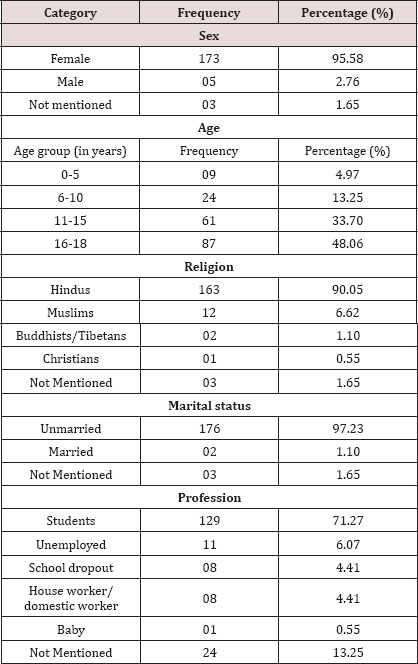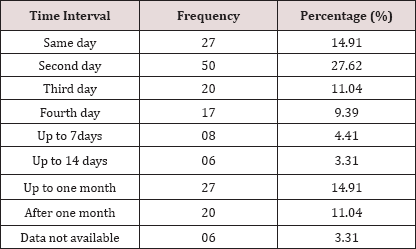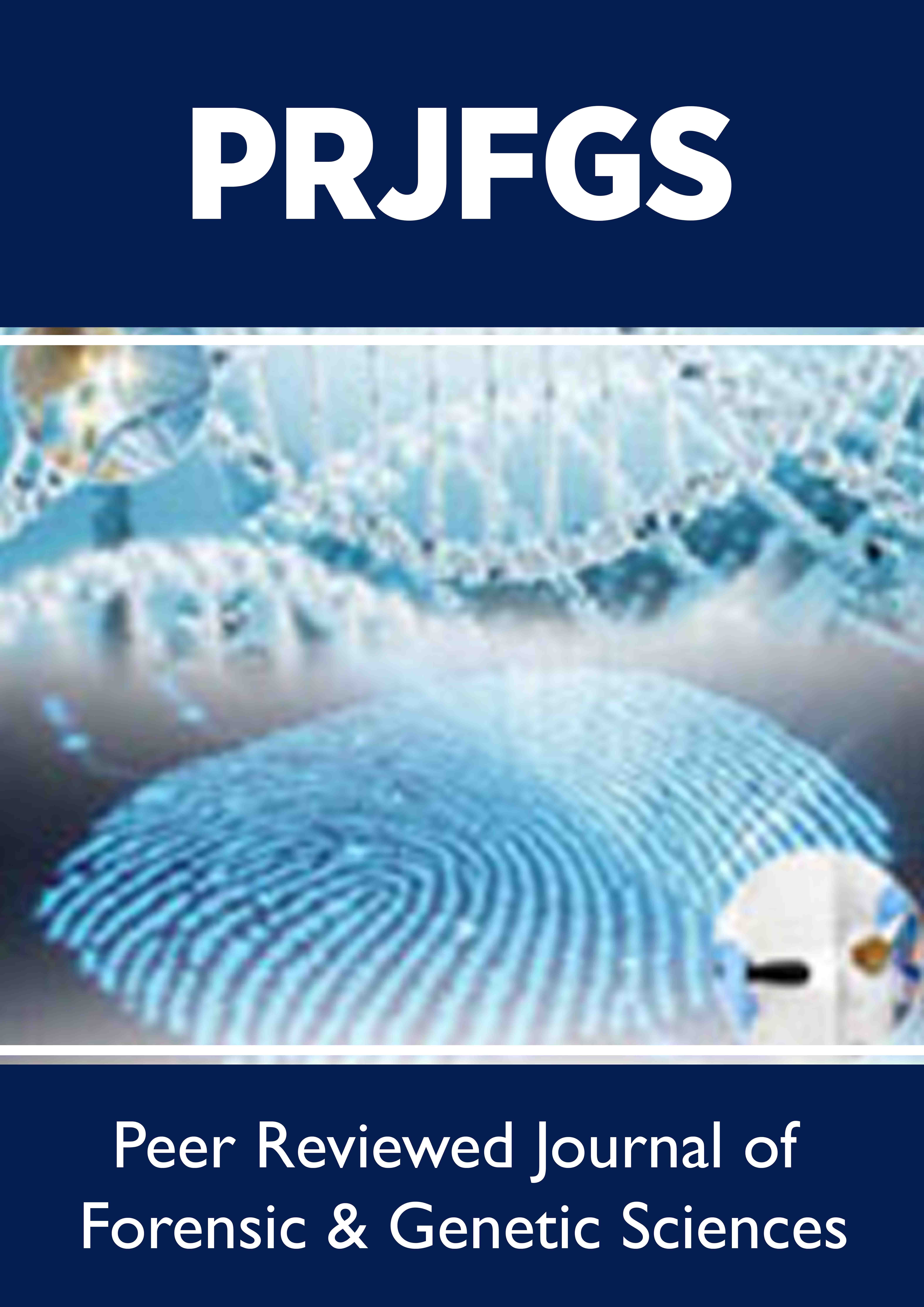
Lupine Publishers Group
Lupine Publishers
Menu
ISSN: 2638-6062
Research Article(ISSN: 2638-6062) 
Forensic Study of Child Sexual Abuse in Northern Range of Himachal Pradesh Volume 1 - Issue 3
Surender Kumar Pal1*, Ajay Rana2, Arun Sharma3 and Ajay Sehgal4
- 1Assistant Director, Biology & Serology Division, Regional Forensic Science Laboratory, India
- 2Scientific Assistant, Biology & Serology Division, Regional Forensic Science Laboratory, India
- 3Director, Directorate of Forensic Science, India
- 4Scientific Officer, Biology & Serology Division, Regional Forensic Science Laboratory, India
Received: March 28, 2018; Published: April 03, 2018
*Corresponding author: Surender Kumar Pal, Assistant Director, Biology and Serology Division, Regional Forensic Science Laboratory, Himachal Pradesh, India
DOI: 10.32474/PRJFGS.2018.01.000112
Abstract
Background: The Protection of Children from Sexual Offences (POCSO) Act, 2012 had made a significant contribution for trickling the cases against children and adolescents. The aim of the present study is to determine the socio-demographic profile of sexually assaulted children and their medico legal aspects.
Material and Methods: The study was conducted on 181 cases of sexual assaults registered under POCSO Act, 2012 received for examination at Regional Forensic Science Laboratory, Northern Range, Dharamshala, and Himachal Pradesh, India during the year 2013-2016. The details pertaining to socio-demographic factors (sex, age, religion, and profession), season, place of incidence, relationship with accused, time interval between alleged incidence and medical examinations, condition of hymen and results of exhibits examined in forensic lab were noted in a self-designed per forma.
Results: The cases of female sexual assaults (95.58%) outnumbered the male sexual assaults (2.76%). 90.05% victims were Hindus followed by Muslims (6.62%), Buddhists/Tibetans (1.10%), and Christians (0.55%). The most commonly sexual assaults were reported in the month of winter (31.49%) followed by monsoon (29.83%), summer (24.30%) and autumn (14.36%). The common site of offence was the house of accused (38.67%) followed by house of victim (17.12%).This study revealed that most vulnerable age group was 16-18 years (48.06%). 71.27%of the alleged sexual assault victims were students. Most commonly sexual crimes were committed by the person familiar to the victim (85.63%).97.23% victims were unmarried and1.10% were married. Maximum numbers of victims were medico-legally examined on second day of incidence (27.62%). Hymen was found intact in 12.15% female victims and torn/ruptured with old tears in 22.09% cases. Recent tears were noticed in 43.09% female victims. Spermatozoa were detected in 30.93% cases on undergarments, pubic hair, vaginal swabs, vaginal smear slides, clothes and bed sheets.
Conclusion: Most commonly sexual assaults are committed by the familiar persons and the place of incidence was either house of the accused or victim. The most vulnerable age group was 16-18 years. Delay in medico legal examination and delay in reporting caused loss of biological evidences.
Keywords: Sexual Assault; Female Victims; Male Victims; Assailants; Hymen; Medico-Legal Examination
Introduction
The Protection of Children from Sexual Offences (POCSO) Act, 2012 deals with sexual offences against persons below 18 years of age, who are deemed as children. The Act has come into force on the 14th of November, 2012, along with the rules framed. The Act for the first time, defines penetrative sexual assault, sexual assault and sexual harassment. This Act is a comprehensive law to provide the protection of children from the offences of sexual assault, sexual harassment and pornography, while safeguarding the interests of the child at every stage of the judicial process by incorporating child-friendly mechanisms for reporting, recording of evidence, investigation and speedy trial of offences through appointment of special public prosecutors and designated special courts [1].
The WHO in 2002 estimated that 73 million boys and 150 million girls under the age of 18 years had experienced various forms of sexual violence [2]. For every 155th minute a child, less than 16 years is raped, for every 13th hour child under 10, and one in every 10 children sexually abused at any point of time [3]. India is home to 19% of the world's children. As per the 2001 census, about 440 million individuals in India were below 18 years of age and constitute 42% of total population [4]. Studies propose that over 7,200 children, including infants, are raped every year and it is believed that several cases go unreported. It is estimated by the Government that 40% of India's children are susceptible to threats like being homeless, trafficking, drug abuse, forced labor, and crime[5].In India, every second child is being exposed to one or the other form of sexual abuse and every fifth child faces critical forms of it [6].
In the modern era, the internet has changed life of the people and playing a great role in sex crimes. The new technologies and cyber stalking provide new ways of harassment and intimidation of children. The NCRB data for the year 2016 has registered a sharp spike in cases of children-even as overall crimes against children have increased. According to NCRB data for 2016, incidences of rape of children have increased by over 82% as compared to 2015 [7]. Until 2012, the only sexual offences against children recognized by the law were covered by three sections of the Indian Penal Code (IPC) and were not specific to children. The only crimes registered were rape, outraging modesty of woman and unnatural acts defined as carnal intercourse against the order of nature with any man, woman or animal [8].
Child sexual assault is a serious abuse, pervasive social issue and POCSO Act is formulated to effectively address the heinous crimes of sexual abuse and sexual exploitations of children [9]. Sexual violence is ubiquitous; it occurs in every culture, in all levels of society and in every country of the world. Sexual violence has significant negative impact on the health of the population [10]. Sex crimes are complex and multidimensional. Children and adolescent oriented sexual assaults are increasing and both females and males become victims of this heinous crime in high percentages in any period of their lives [11]. Child sexual abuse or child molestation is a form of abuse in which an adult or older adolescent uses a child for sexual stimulation. It is a kind of physical or mental violation of child with a sexual intent usually by a person [12]. The adverse effects of child sexual abuse are psychological, physical, behavioral and interpersonal [13]. Growing concerns about female infanticide, child rapes and institutional abuse of children led to the commissioning of the large scale Government sponsored research study to assess the extent and nature of child abuse in India [14].
Material and Methods
This study was conducted in Biology and Serology Division of Regional Forensic Science Laboratory, Northern Range, Dharamshala, Himachal Pradesh, India. It was based on the cases of alleged sexual assaults registered under POCSO Act, 2012 received for examination from three districts (Kangra, Chambaand Una) of Himachal Pradesh, India during the year 2013to2016. The data was retrieved from police forwarding letter, medico-legal certificates, history revealed by the victim during examination and results of forensic laboratory examination of the exhibits. The details pertaining to socio-demographic factors such as sex, age, religion, marital status, profession, season, place of incidence, relationship with accused, time interval between alleged incidence and medical examinations, condition of hymen and results of forensic examination of exhibits were entered on a self-designed Performa. The data was then statistically analyzed and discussed.
Results
In the present study, 181 cases of child sexual assault were examined during the years 2013 to 2016. Out of 181 cases, 173(95.58%) were of female sexual assault and 05(2.76%) were of male sexual assault (Table 1). The age of victim ranged from a few days to 18 years. The most vulnerable age group was 16-18years (48.06%) followed by 11-15 years (33.70%), 6-10 years(13.25%), and 0-5 years(4.97%). Most of the victims were Hindus 163 (90.05%) followed by Muslims 12 (6.62%), Buddhists/Tibetans 2(1.10%) and Christian 1 (0.55%).176(97.23%) victims of sexual assault were unmarried followed by married in 2(1.10%) cases. The majority of the victims 129(71.27%) were students followed by unemployed in 11(6.07%), school dropped out in 08(4.41%) and house workers/domestic workers in 08(4.41%) cases. Most assaults were reported in winter season (31.49%) followed by monsoon season (29.83%), summer season (24.30%) and autumn season (14.36%) (Table 2).
Table 1: Socio demographic profile of sexual assault victims.

Table 2: Sexual assaults according to season.

The common site of assault was the house of accused in 70(38.67%) cases followed by the house of victim in 31(17.12%), jungles/field sin 17(9.39%) and roadside in 11(6.07%) cases b (Table 3). In 162(89.50%) cases of female sexual assaults, the act was committed by familiar persons, while 19 (10.49%) cases assailants were unfamiliar to the victims. In 53(29.23%) cases, the alleged accused were friends followed by neighbors' in 48(26.51%), relatives in 25(13.81%) and strangers in 19(10.49%) cases. In 12(6.62%) cases, female victims were sexually assaulted by family members (father, uncle and grandfather) (Table 4). 50(27.62%) cases were medico-legally examined on second day of incidence followed by 45(24.86%) in third day to a week, 33 (18.23%) after a week to month, 27(14.91%) on the same day and 20(11.04%) after one month (Table 5). Hymen was found ruptured/torn with recent tears in 78(43.09%), ruptured/torn with old tears in 40 (22.09%), intact in 22(12.15%) and absent in 10(5.24%) victims of sexual assaults (Table 6). Spermatozoa was detected in 56(30.93%) cases of sexual assault on undergarments, pubic hair, vaginal swabs, vaginal smear slides, clothes and bed sheets indicating recent vaginal intercourse (Table 7).
Table 3: Place of incidence.

Table 4: Sexual assault victims according to relationship to accused.

Table 5: Time interval between the alleged incidence and the medical examination.

Table 6: Condition/status of Hymen.

Table 7: Detection of spermatozoa according to FSL reports.

Discussion
Sexual abuse is common in all races, cultures and socio-economic groups across the globe. Various studies conducted throughout the world showed that sexual assaults cases are increasing in both children and adolescents [15,16]. Girls are more vulnerable to sexual abuse, although boys too reported a high percentage of victimization and are subjected to greater social stigma [17]. In our study, majority of victims were females 173 (95.58%), while males were sexually assaulted in 5(2.76%) cases only. These results are in agreement with the study of Sarkar et al. [18], Tamuli et al. [19] and Momonchand [20]. The prevalence of low percentage of male victims may be because of underreporting, sex stereotyping, social denial, minimization of male victimization and the relative lack of research on sexual abuse of boys [11].
Our study revealed that 33(18.23%) children were younger than 10 years, while 148(81.76%) cases were in the age range of 10-18 years. In a study done by Sharma et al in Punjab-an adjoining state of Himachal Pradesh, it was observed that the incidence of alleged rape was most amongst girls of 15-18 years [21]. Similar findings were noticed by McCann et al. [22] in their study. In this study, the most vulnerable age was 16-18 year sin 87(48.06%) cases followed by 11-15 year sin 61(33.70%) cases. Our study is in agreement with study of Demireva et al. [23] who reported 38.73% victims in the age group of 14-17 and Kaushik et al. [24] which revealed the incidence of alleged rape in 45.16% cases in the age group of 14-17 years. Similar findings were made in the studies by Tamuli et al. [19], Haider et al. [25] and Sarkar et al. [18] who reported 11-20 years as the highly affected age group. This strengthens the provision of the POCSO Act, where children under 18 years of age cannot give consent for sexual intercourse despite consent. In our study, there are majority of victims who permitted for sex but there ages were less than eighteen years. This shows lack of awareness about the legal age of sex for both genders. The cases were reported from Hindus, Muslims, and Buddhists/Tibetans. In the present study most of the victims were Hindus 163(90.05%) followed by Muslims in 12(6.62%), Buddhists/Tibetansin 02(1.10%) cases and Christian in 1(0.55%) case only. The findings are in agreement with study of Yadav et al. [26] and Bhowmik and Chahila [27].
This can be explained by the fact that Hindus predominance in most of the areas under study. 176(97.23%) victims of sexual assaults were unmarried as 2 (1.10%) were married. Similar findings were made by Suri and Sanjeeda [28] who reported that 96% victims were unmarried and only 4 % were married. In the present study, most of the victims were students 129(71.27%). reported that 48.57% victims were students, while Tailor et al. [29] reported one quarter (23.4%) of the victims were students and Yadav et al. [26] reported that 51% of the victims were students. Maximum numbers of victims in our study were students as mostly the children go to school in this age group. In our study, the maximum numbers of cases were reported during the month of winter (31.49%) followed by monsoon (29.83%), summer (24.30%) and autumn (14.36%). Tamuli et al. [19] observed that most of the cases occurred during month of October, November and April. Sukul et al. [30] reported that majority of the cases were occurred during summer months (April to August) with peak in May (14.94%). This can be explained by geographical and seasonal variations among the various parts of the globe.
In our study, the common site of incidence was the house of accused in 70(38.67%)cases followed by the house of victim in 31(17.12%) cases and at various places in 80(44.19 %) cases. Our findings are consistent with the study of Maring et al. [31] who reported accused house as common site of offence in 40.54 % cases and Haridas et al. [10] who reported accused house as common site of offence in 45.39% cases. Our study is also consistent with the study by Roy Chowdhary et al. [32] who reported 22.5% incidences in victims' house. This may be due to the fact that in most of cases, victim voluntarily ran away with assailant due to love affair and later caught by police at accused house and various places after a complaint lodged by victims’ parents at police station. In the present study, significant relationship was noted between the victim and perpetrator as the offence occurred in a familiar setting. As faras relation of accused with the victim was concerned, sexual assault was committed by persons acquainted with victims in 162(89.50%) cases, while in 19(10.49%) cases, the assailants were strangers. Our study is in accordance with the study of Islam et al. [33] who reported that in 88.2% cases, victims knew the assailants and in 11.8% cases, assailants were strangers to the victims; Yadav who reported that 90.4% victims knew the assailants and who reported that about 77% of the assailants were known to the victims. In our study, 48(26.51%) assailants were neighbors' and in 23 (12.70%) cases accused were friends. Our study is consistent with the study made by Jain et al. [34] who reported that in 15.75% of cases, accused were friends of the victim. Our study is not in agreement with the study made by who reported that in 74.9% cases assailants were friends of the victims. Neighbors were noted as assailants in the studies made by in 13.7% cases, by in 1.8% cases and by in 46.75% cases. From these studies, it can be concluded that most of the threat to the victims is from known persons in their social circle. Thus closeness or relationship of some or other kind may convinced the victim for sexual act.
In our study, 12 (6.62%) victims were sexually assaulted by family members, while 25(13.81%) victims were sexually assaulted by close relatives. Our study is almost similar to the study made by who reported that 8.55% victims were sexually assaulted by family members. El-Elemi et al. [35] reported father-daughter incest in 3(7.5%) cases. In the present study, the time elapsed between sexual act and medico-legal examination ranged from same day to more than one month. The maximum number of victims 50(27.62%) were examined on second day of assault followed by 45(24.86%) in third day to a week, 33(18.23%) after a week to month, 27(14.91%) on the same day and 20(11.04%) after one month. In a study by 24.3% victims were examined on second day of incidence and 17.5% were examined after months of assault and reported that 27.05% cases were examined on the second day of assault and 8.45% were examined after months of assault which is in accordance with our study. In our study, only 14.91% victims were examined on the day of incidence which is consistent with the study made by who reported that 10% victims were examined on the same day of assault. Delay in reporting of cases may be due to indecisiveness on the part of victim, victim's parents and relatives to report cases fear of off ender and indignity, fear of parents/ guardian social stigma, gap in communication between parents and children about the issue and in some circumstances victim eloped with accused to another place.
In our study, hymen was found ruptured/torn with recent tear in 78(43.09%), ruptured/torn with old tear in 40(22.09%), intact in 22(12.15%) and absent in 10 (5.24%) victims of sexual assault. Our study is consistent with the study of where hymen rupture was reported in 85% cases, majority of which were old tears. This study is in agreement with who reported that hymen was intact in 13.3% cases. Our study is also consistent with Lackew [36] who noticed recent hymenal tears in 42.9% cases. Adams et al. [37] reported recent hymen tear in 22% cases and Sukul et al. [30] found old hymenal tears in 86.2% cases. Kar et al. [38] reported that 28.2% victims had old hymenal tears and 3.8% had recent tears of hymen. These findings showed that recent and old hymenal tears were reported in majority of cases. Hymen tears is not the criteria to fix sexual intercourse as inserting tampons, masturbating, or participating in strenuous physical activities like gymnastics or horseback can cause rupture to the hymen. The microscopic detection of spermatozoa in the stains and swabs is usually used to confirm the presence of semen and thus scientifically corroborate an alleged sexual offence. In the present study, 56(30.93%) cases of female sexual assaults were found positive for spermatozoa and negative in 125(69.06%) cases. The results of the present study are in agreement with study of who reported semen in 27.77% cases and negative in 72.22% cases, AlMadni et al. [39] who detected semen in 28.3% cases and who reported positivity for spermatozoa in 22.85% cases. The causes of non-detection of spermatozoa in most of cases were due to delayed in reporting/disclosure, uses of condom, washings of genitals, bathing or showering and sexual intercourse with ejaculation outside the private part. Even in Western countries only 10-15% rape incidents were reported to the police [40].
Conclusion
POCSO Act, 2012 made a significant contribution to deal with child sexual abuse cases in India. With rising the numbers of reported cases indicate that law plays an important role in educating the people and sensitizing the criminal justice system. Child sexual abuse is a heinous crime and no age group can be considered as safe, though young girls and adolescents are at risk. Most affective age group was 16-18 years as this is a tender age. House of the accused is the commonest place of offence. Biggest threat to the victims is not form the strangers but from the known persons so there is a need of develop moral values and ethics among people in the transitional phase of cultural devaluation. Delay in reporting of cases and medico legal examination causes loss of significant trace biological evidences, so there is a need of early reporting of the cases.
References
- Protection of Children from Sexual Offences (POCSO) Act (2012) Ministry of Women and Child Development, Government of India, New Delhi.
- Geneva: World Health organization; Child maltreatment (2014).
- Child line organization. Childline1098service.
- Behere PB, Mulmule AN (2013) Sexual abuse in 8 year old child: Where do we stand legally? Indian J Psychol Med 35(2): 203-205.
- Breaking the silence. Child sexual abuse in India. USA, Humans rights watch (2013).
- Behere PB, Sathyanarayana, Rao TS, Mulmule AN (2013) Sexual abuse in women with special reference to children: barriers, boundaries and beyond. Indian J Psychiatry 55(4): 316-319.
- NCRB data (2016): Huge spike in rape of children, up by 82% from (2015) UP, MP worst states, TN new entrant.
- Belur J, Bahadur BS (2015) Child sexual abuse and the law in India: a commentary. Crime Sci 4: 26.
- Kulkarni UK, Kulkarni KV, Kokre R N, Daundkar BB (2016) Forensic Study on child abuse on sexual abuse under POCSO act. European Journal of Biomedical and Pharmaceutical Sciences 3(7).
- Haridas S, Nanandkar SDS (2016) Medicolegal study of alleged rape victim cases in Mumbai Region. International journal of Medical Toxicology and Forensic Medicine 6(1): 12-22.
- Arif M, Ahmed M, Chaudhary MK (2014) Medico legal analysis of child and adolescent victims of sexual assault in Lahore- A Retrospective Study. PJMHS 8(2): 446-452.
- Kumar SP, Sharma A, Sehgal AK, Rana AS (2014) A study of sexual assaults in northern Range of Himachal Pradesh. International Journal of Medical Toxicology and Forensic Medicine 5(2) 64-72.
- Miller KL, Dove MK, Miller SM (2007) A counselor's guide to child sexual abuse: Prevention, reporting and treatment strategies.?
- Kacker L, Mohsin N, Dixit A (2007) Study on child abuse: India. Ministry of Women and Child Development, Government of India, New Delhi.
- Wiley J, Sugar N, Fine D, Eckert LO (2003) Legal outcomes of sexual assaults of sexual assault. Am J ObstetGynecol 188(6): 1638-1641.
- Grossin C, Sibille I, Grandmaison GIDI, Banasar A, Brion F, et al. (2003) Analysis of 418 cases of sexual assault. Forensic Science Int 131(2-3): 125-130.
- Carson D, Foster J, Tripathi N (2013) Child abuse in India: current issues and research. Psychological Studies 58(3): 318-325.
- Sarkar SC, Lalwani S, Rautji R, Bhardwaj DN, Dogra TD (2005) A study on victims of sexual offences in South Delhi. J Famwelf 51(1): 60-66.
- Tamuli RP, Paul B, Mahanta P (2013) A statistical analysis of alleged victims of sexual assault a retrospective study. J Punjab Acad Forensic Med Toxicol 13(1): 7.
- Momonchand A, Pradip Kumar KH (2003) Alleged rape in and around Imphal. J Indian Acad Forensic Med 25:147-9.
- Sharma DC, Aggarwal KK, Bhullar DS (2008) Analysis of vaginal swab examination vis-a-vis magnitude of rape in Punjab. J Indian Acad Forensic Med 30(4): 186-192.
- McCrann D, Lalor K, Katabaro JK (2006) Childhood sexual abuse among university students in Tanzania. Child Abuse Negi 30: 1343-451.
- Demireva DR, Dimitrova MR, Burulyanova IS (2013) Comparative investigation of the incidence of sexual assault in three regions of the Republic of Bulgaria during 1997-2006. Acta Fac Med Naiss 30(2):85-92.
- Kaushik N, Pal S, Sharma A, Thakur GC (2016) A Retrospective study of sexual assaults in southern range of Himachal Pradesh. IJHSR 6(2): 342351.
- Haider A, Kamran S, Khan Jet al (2014) A study of female sexual offences in the year 2013 at DHQ Hospital Dera Ismail Khan. Ann Pak Inst MedSci 10(4): 187-192.
- Yadav A, Meena RL, Pathak D et al (2014) A five year retrospective study of victims of sexual offences in Jaipur region. Indian Journal of Forensic Medicine and Toxicology 8(2):89-93.
- Bhowmik K, Chaliha R (2011) A descriptive one year study on the alleged male and female victims and accused of sex crime. J Indian Acad Forensic Med 33(3): 214-20.
- Suri S, Sanjeeda (2013) An analytical study of rape in Delhi. International Journal of Education and Psychosocial Research 2(3): 60-68.
- Tailor C, Govekar G, Patel Get al (2010) The profile of age in cases of victims of sexual offence. J Indian Acad Forensic Med 32(4):303-307.
- Sukul B, Chattopadhyay S, Bose TK (2009) A study of the victims of natural sexual offence in Bankura district of West Bengal. J Indian Acad Forensic Med 31(1):25-29.
- 31. Maring SK, Meera T, Singh TB, Nabachandra H (2013) Child sexual assault: A study in Manipur. Journal of Medical Society 27(3): 187-191.
- Roy Chowdhary UB, Bose TK, Prasad R (2008) Rape: Its medico legal and social aspect. J Indian Acad Forensic Med 30(2): 69-71.
- Islam MN, See KL, Ting LC, Khan J (2006) Pattern of sexual offences attended at accident and emergency department of HUSM from 2000 to 2003: a retrospective study. Malaysian Journal of Forensic Sciences 13(1):30-36.
- Jain R, Mathur PN, Kothari NS, Mathur P (2008) Medicolegal evaluation of sex assault cases admitted at sardarpatel Medical College P.B.M. Hospital Bikaner India, Medicolegal update. An international Journal 8(1): 11-15.
- El-Elemi AH, Moustafa SM, Hagras AM (2011) Reported cases of female sexual assault over 5 years period in Suiz canal area, Egypt: demographic study. Egypt J Forensic Sci 1: 118-23.
- Lackew Z (2001) Alleged cases of sexual assault reported to two Addis Ababa hospitals. East African Medical Journal 78(2): 80-83.
- Adams JA, Girardin B, Faugno D (2003) Signs of genital trauma in adolescent rape victim examined acutely. J Pediatr Adolesc Gynecol 13(2): 88.
- Kar H, Aslan MM, Cekin N, Akcan R, Hilala A (2010) Sexual assault in childhood and adolescent: a survey study. European Journal of Social Sciences 13(4): 549-55.
- AlMadni O, Bamousa M, Alsaif D, Kharoshah MAA, Alsowayigh K (2012) Child physical and sexual abuse in Dammam Saudi Arabia. A descriptive case analysis study. Egyptian Journal of Forensic Sciences 2: 33-37.
- Denny Quadagno (1992) Human sexuality, (2nd Edn.), St. Louis Mosby Year Book Inc p. 597.

Top Editors
-

Mark E Smith
Bio chemistry
University of Texas Medical Branch, USA -

Lawrence A Presley
Department of Criminal Justice
Liberty University, USA -

Thomas W Miller
Department of Psychiatry
University of Kentucky, USA -

Gjumrakch Aliev
Department of Medicine
Gally International Biomedical Research & Consulting LLC, USA -

Christopher Bryant
Department of Urbanisation and Agricultural
Montreal university, USA -

Robert William Frare
Oral & Maxillofacial Pathology
New York University, USA -

Rudolph Modesto Navari
Gastroenterology and Hepatology
University of Alabama, UK -

Andrew Hague
Department of Medicine
Universities of Bradford, UK -

George Gregory Buttigieg
Maltese College of Obstetrics and Gynaecology, Europe -

Chen-Hsiung Yeh
Oncology
Circulogene Theranostics, England -
.png)
Emilio Bucio-Carrillo
Radiation Chemistry
National University of Mexico, USA -
.jpg)
Casey J Grenier
Analytical Chemistry
Wentworth Institute of Technology, USA -
Hany Atalah
Minimally Invasive Surgery
Mercer University school of Medicine, USA -

Abu-Hussein Muhamad
Pediatric Dentistry
University of Athens , Greece

The annual scholar awards from Lupine Publishers honor a selected number Read More...










